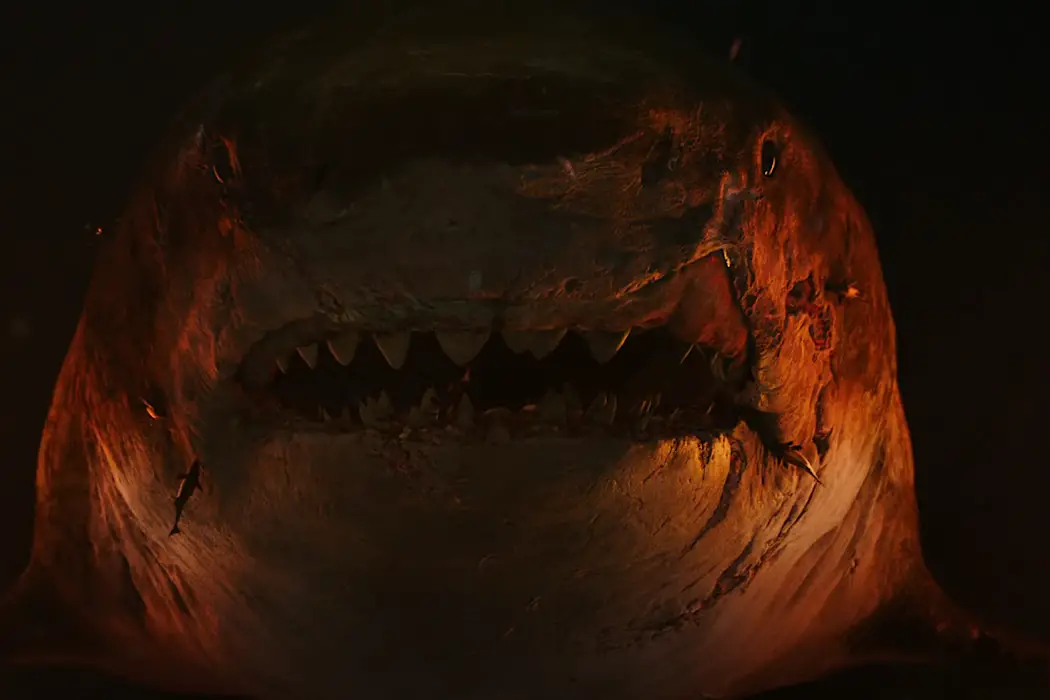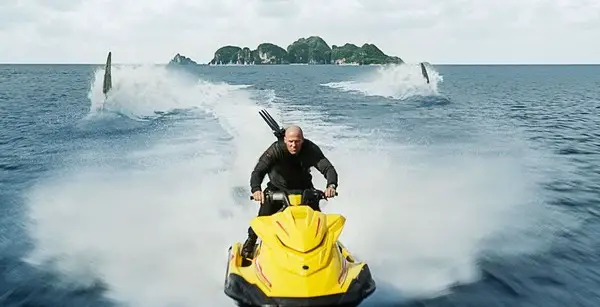MEG 2: THE TRENCH: Jumping the Shark Sequel

Payton McCarty-Simas is a freelance writer and artist based in…
Since the summer of 1978, one kind of horror film has reliably provided audiences with an excuse to get out of the sun for a couple of hours, grab some popcorn, and have a baseline acceptable time at the movies…
The Shark Sequel.

Jaws 2, the follow-up to Spielberg‘s classic summer blockbuster whose success single-handedly ushered in a new age of Galeophobia set the template for this kind of middling, dog days fare: The plot of the first film happens again, but this time, it’s just not as good. Where before there was narrative, now there’s only shark. There’s another shark. It’s not exactly the same shark, but it’s angry anyway. And boy, is it hungry. Chomp!
An Unholy Subgenre
The Meg (2018) certainly wasn’t a masterpiece of cinema, but it was a perfectly good way to spend a summer afternoon. Its logic is easy enough to follow: There’s a secret, deeper part of the Mariana Trench than we thought there was, and, by god, megalodons live there. Jason Statham, Hollywood’s most reliable B-list action star, fights giant squids and blows up sharks with his quippy, ragtag team of renegade deep-sea divers. The characters aren’t new or exciting, but the cast has obvious chemistry and under the direction of National Treasure’s own Jon Turtletaub, the movie’s action churns along at a pleasant, goofy clip, providing all the sharks anyone could want for one summer.
Meg 2: The Trench (directed by A Field in England‘s Ben Wheatley) doesn’t live up to its predecessor in almost any way: Its first ninety minutes drag and jerk along like a Jules Verne novel gone bad, it’s clunky, strangely confusing, and simply doesn’t have enough shark to justify even its under two-hour runtime. But really, it doesn’t have to. It’s a Shark Sequel, and marches to the beat of that unholy subgenre–– as Jason Statham repeatedly tells his adopted daughter Meiying (Shuya Sophia Cai), when you’re in a trench filled with prehistoric megafauna, all you have to do is “do what’s in front of you, and then you do the next thing.”

The film follows Taylor and his team as they travel to The Trench on a routine exploratory mission, only to discover that someone has set up a Secret Villain Base on the seafloor. To make matters worse, someone on their team is involved, sabotaging equipment and putting the team’s lives at risk. To survive, the gang must uncover the plot and bring the villains to justice without getting eaten, shot, or drowned. But this is a Shark Sequel, and that description makes too much sense.
“Who Cares??”
As with Jaws 2, there’s a bizarre randomness to the proceedings that flies in the face of what could have easily been a straightforward premise (big shark eats people). The film opens on a prehistoric beach with a Meg gobbling a T-Rex, Jurassic World-style. Why not! Next, Taylor (Statham‘s character, whose job at the oceanographic institute from the first film now seems to be “celebrity eco-vigilante”), citizen-arrests some seafaring thugs for illegally dumping nuclear waste into the ocean near the trench, giving the impression that there will be radioactive Super-Megs in the film. There are not. In fact, it’s never mentioned again. The plot of Meg 2: The Trench quickly takes on an almost AI-generated quality as these dissociative elements stack up. There’s the scene at a fundraising gala where Taylor has to contend with the burden of celebrity, grinning for selfies he despises with donors he deplores. That potential character arc is abandoned. There’s Haiqi, the Meg the researchers captured as a pup and have seemingly trained to not eat people (by responding to a clicker), in another twist that resembles Jurassic World. For all the hype around this miracle of paleo-ichthyology, one might expect the well-trained Haiqi to fight the Bad Megs a la Godzilla vs. Kong. She does not. There’s the corporate scheme at the heart of the film’s action, headed by a cavalcade of characters with motives like “greed” and “revenge” that are so thinly drawn people just announce them to each other (“Can you just stop whining about climate change? Who cares!” “We’re gonna plunder your oceans for decades!”). There are poison-tipped bullets (“just like Jaws 2“) that are mentioned but never even shown. There’s a giant, Meg-eating octopus that goes literally verbally unacknowledged throughout the entire film even as it attacks hundreds of people.
If these confusing plot points sound fun, sometimes they are! But to be clear: like all Shark Sequels, this film is largely shambolic, befuddled, and boring. Its dark, murky visuals render some moments geographically and even narratively impossible to parse (interestingly, whether the location in question is a field, a warehouse as in Free Fire, or yes, a trench, Ben Wheatley seems unable to create clear spatial relations in any of his films). It can be genuinely annoying to figure out what’s happening in a given scene. Most of the actors seem pained. Jaws 2 is no Jaws, and silly though they both may be, Meg 2 is no The Meg.

Yet, at a certain point, the film’s go-for-broke maximalist silliness is its greatest strength. Yes, the movie is slow and often boring, yes, The Trench is so immense that the Megs honestly don’t even look that big, and yes, every character feels like an adult written by a child in a 2000s action-comedy. But about midway through, Jason Statham‘s character swims around The Trench (that is, the secret, deeper trench below the Mariana Trench) without a suit or helmet, somehow “trapping enough oxygen in his nose” to breathe underwater for several minutes because, as one character actually puts it, “think about it, fish don’t need suits” to survive (was his intro to Queen’s “Under Pressure” the best foreshadowing in the movie?).
Moments of sublime, irresistible nonsense like this inspire a gleeful fascination that transcends the overall slog of the film–– and so, on a whim, I actually reached out to the team at the Maria Mitchell Association’s Science Center on Nantucket to understand exactly what would happen to a human body at such a depth. Katherine Whittle, a biology research intern at the center’s aquarium, shared her insight in fabulous scientific detail. She informed me that not even fish would be likely to survive the high pressure of The Trench, which would realistically host little more than “colonies of single-celled organisms”–– no Megs. As for Statham, she told me, “Yes, a human would absolutely die instantly” and be “hella crushed” by the pressure. To top that off, “The assumption is that at that depth you’re not breathing regular surface-level oxygen blends, so [he] would do worse” with air in his nose. “Your lungs would be compressed, so holding in air would actually cause more external pressure on your body. Having a higher concentration of gasses in the lungs versus in the blood is a huge problem. Oxygen can become toxic at depth because of partial pressure stuff. DUMB.”
Conclusion:
But hey! In a Shark Sequel, jumping the shark isn’t just acceptable, it’s a given, and woe unto anyone who thought Meg 2: The Trench was going to make sense. In its final climactic sequence wherein lots of Megs (finally) escape The Trench, countless margarita-chugging tourists get swallowed and the unkillable Jason Statham plays Captain Ahab on a jetski with exploding harpoons. If you liked Jaws 2 (or Sharknado 2, Deep Blue Sea 2, Open Water 2, Ouija Shark 2, etc. etc), this bad Shark Sequel has everything you need. As the credits roll, an original rap by Page Kennedy (who acts in the film) sums up the genre better than anything else could: “Chomp!” he raps, “Chomp! Chomp on it! Megalodon!”
The Meg 2: The Trench was released in theaters on August 4th.
Watch Meg 2: The Trench
Does content like this matter to you?
Become a Member and support film journalism. Unlock access to all of Film Inquiry`s great articles. Join a community of like-minded readers who are passionate about cinema - get access to our private members Network, give back to independent filmmakers, and more.
Payton McCarty-Simas is a freelance writer and artist based in New York City. They grew up in Massachusetts devouring Stephen King novels, Edgar Allan Poe stories, and Scooby Doo on VHS. Payton holds a masters degree in film and media studies from Columbia University and her work focuses on horror film, psychedelia, and the occult in particular. Their first book, One Step Short of Crazy: National Treasure and the Landscape of American Conspiracy Culture, is due for release in November.












